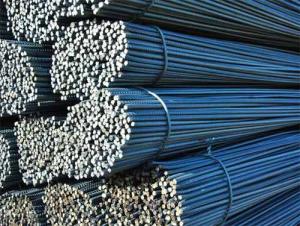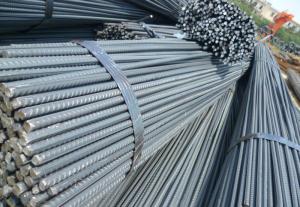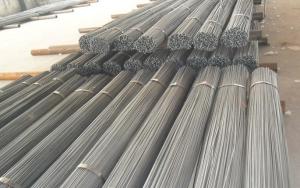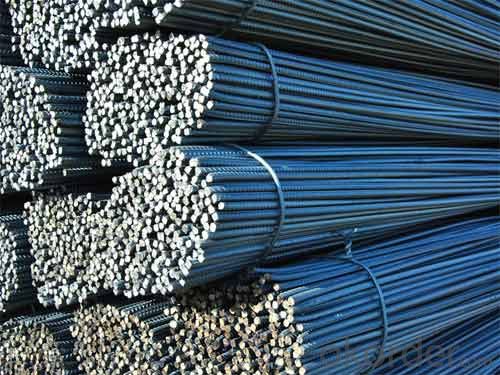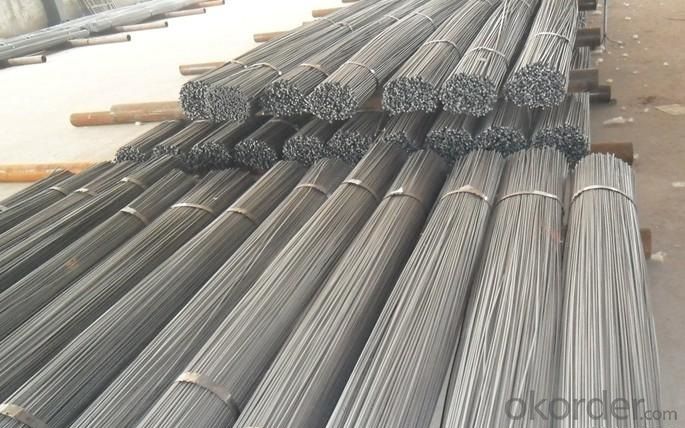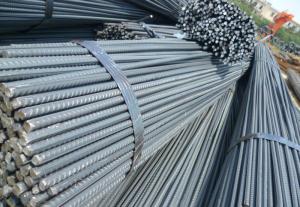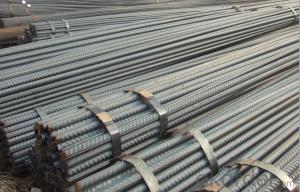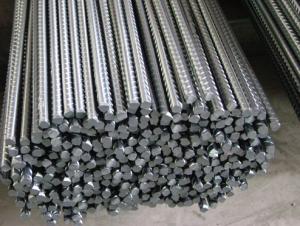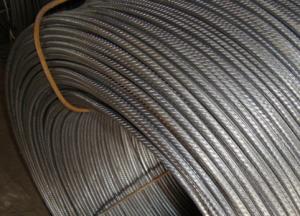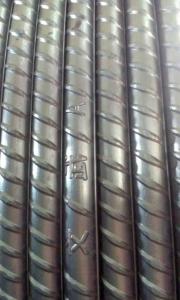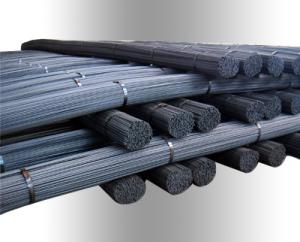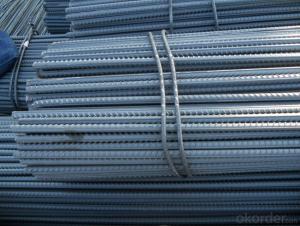Twelve mm Cold Rolled Steel Rebars with High Quality
- Loading Port:
- Tianjin
- Payment Terms:
- TT or LC
- Min Order Qty:
- 50 m.t.
- Supply Capability:
- 15000 m.t./month
OKorder Service Pledge
OKorder Financial Service
You Might Also Like
Specifications of Twelve mm Cold Rolled Steel Rebars with High Quality:
Name | Cold Rolled Steel Rebar | |
Diameter | 5mm, 5.5mm, 6mm, 6.5mm, 7mm, 8mm, 9mm, 10mm, 11mm, 12mm, | |
Length | 6M, 9M, 12M or as required | |
Price | Keep lower operating costs so as to offer competitive price for our clients | |
Label | to be specified by customer, generally, each bundle has 1-2 labels | |
Application | Building, construction | |
Invoicing | Actual or Theoretical Weight Basis as buyer’s request. | |
Theoretical weight and section area of each diameter of Twelve mm Cold Rolled Steel Rebars with High Quality as below for your information:
Diameter(mm) | Section area (mm²) | Mass(kg/m) | Weight of 12m (kg) | Pcs/ton |
12 | 113.04 | 0.888 | 10.656 | 93.84 |
Packaging & Delivery of Twelve mm Cold Rolled Steel Rebars with High Quality:
Packaging Detail: products are packed in bundle and then shipped by container or bulk vessel, deformed bar is usually naked strapping delivery, when storing, please pay attention to moisture proof. The performance of rust will produce adverse effect.
Each bundle weight: 2-3MT, or as required
Payment terms: TT payment in advance or Irrevocable LC at sight.
Trade terms :FOB, CFR, CIF
Delivery Detail: within 45 days after received advanced payment or LC.
FAQ:
Q1: Why buy Materials & Equipment from OKorder.com?
A1: All products offered byOKorder.com are carefully selected from China's most reliable manufacturing enterprises. Through its ISO certifications, OKorder.com adheres to the highest standards and a commitment to supply chain safety and customer satisfaction.
Q2: How do we guarantee the quality of our products?
A2: We have established an advanced quality management system which conducts strict quality tests at every step, from raw materials to the final product. At the same time, we provide extensive follow-up service assurances as required.
Q3: How soon can we receive the product after purchase?
A3: Within three days of placing an order, we will arrange production. The shipping date is dependent upon the quatity, how many sizes you want and the plan of production, but is typically 1 month to 2 month days from the beginning of production.
Images of Twelve mm Cold Rolled Steel Rebars with High Quality:
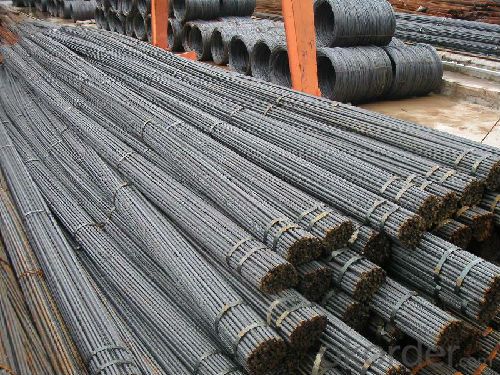
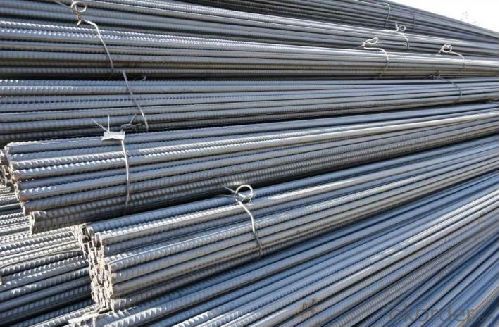
- Q: How do steel rebars improve the ductility of concrete?
- Concrete's ductility is enhanced by steel rebars in several ways. Firstly, the distribution and dissipation of stress throughout the concrete structure is facilitated by the presence of rebars. This prevents the concentration of loads in specific areas, thus preventing cracks or fractures and improving overall ductility. Secondly, when concrete undergoes tension or bending forces, rebars act as reinforcement to resist these forces. The tensile strength of steel rebars is higher compared to concrete, which is weak in tension. This reinforcement allows concrete to withstand higher tensile stresses without breaking, thereby increasing ductility. Furthermore, the bond between steel rebars and the concrete matrix plays a crucial role in improving ductility. The rough surface of rebars provides better adhesion with the surrounding concrete, increasing stress transfer between the two materials. This bond ensures that rebars do not slip out of the concrete during deformation, maintaining structural integrity and enhancing the ductility of the composite material. Additionally, the presence of steel rebars contributes to the post-cracking behavior of concrete. When cracks develop under high loads, rebars help hold the concrete together and prevent further crack propagation. This post-cracking behavior enables concrete to maintain its load-bearing capacity even in a damaged state, thereby improving overall ductility. In conclusion, steel rebars improve concrete's ductility by distributing stress, resisting tension and bending forces, enhancing the bond between concrete and rebars, and providing post-cracking reinforcement. These combined effects result in a more flexible and durable concrete structure capable of withstanding deformation without catastrophic failure.
- Q: What is the impact of steel rebars on the overall energy efficiency of a building?
- Steel rebars have a significant impact on the overall energy efficiency of a building. As an integral part of reinforced concrete structures, rebars provide strength and stability to the building, reducing the need for excessive materials and minimizing energy consumption during construction. Additionally, steel rebars help enhance the thermal performance of a building by improving insulation, reducing heat loss, and increasing energy efficiency in heating and cooling operations. Overall, steel rebars contribute to a more sustainable and energy-efficient building design.
- Q: Are there any specific safety precautions to be taken while handling steel rebars?
- There are several safety measures that need to be taken into account when handling steel rebars. Here are some important factors to consider: 1. Personal Protective Equipment (PPE) is essential. It is crucial to wear the appropriate gear, including safety goggles or glasses, gloves, and steel-toed boots. These items will help safeguard against potential eye injuries, cuts, and crushed toes. 2. Proper lifting techniques must be employed when handling rebars. This involves bending at the knees, maintaining a straight back, and utilizing leg muscles to lift the load. Twisting or jerking movements should be avoided to prevent strains or sprains. 3. Rebars should be stored in an organized and secure manner. They should not be leaned against walls or other structures to avoid falling and causing harm. 4. The sharp edges of rebars should be handled with caution. Careful handling is necessary to prevent cuts or punctures. Wearing protective gloves is recommended to minimize the risk of hand injuries. 5. When transporting rebars, it is crucial to ensure they are secured properly. This prevents movement or falling off the vehicle. Appropriate restraints such as ropes or straps should be used to secure the load safely. 6. It is important to be mindful of any overhead power lines or live electrical sources in the working area. Maintaining a safe distance from these sources prevents accidental contact with the rebars, which can conduct electricity. 7. Communication and awareness among workers are key. Constantly communicating with others in the vicinity ensures that everyone is aware of the presence of rebars. This helps prevent accidental injuries caused by tripping or colliding with the rebars. By adhering to these safety precautions, the risk of accidents or injuries while handling steel rebars can be minimized. It is also important to undergo proper training and comply with any specific safety guidelines provided by your employer or industry regulations.
- Q: What are the guidelines for storing steel rebars on a construction site?
- The guidelines for storing steel rebars on a construction site typically include keeping them off the ground to prevent rust and corrosion, stacking them neatly and securely to avoid accidents, and protecting them from exposure to moisture and other harmful elements. It is also important to separate different sizes and types of rebars to ensure easy identification and accessibility when needed.
- Q: What is the effect of moisture content on the strength of steel rebars?
- The moisture content of steel rebars can have a significant effect on their strength. When steel rebars are exposed to moisture, especially in the form of water or high humidity, it can lead to a process called corrosion. Corrosion occurs when the moisture reacts with the iron in the steel, forming iron oxide or rust. This process weakens the steel rebars and reduces their overall strength. The presence of moisture accelerates the corrosion process, causing the steel rebars to lose their structural integrity over time. Corroded rebars become brittle and are more susceptible to fractures or failure under load. This can be particularly problematic in construction projects where steel rebars are used to reinforce concrete structures, as the corrosion can compromise the durability and safety of the entire structure. In addition to the direct impact on strength, moisture can also contribute to the development of other issues such as cracking, spalling, and concrete degradation. When moisture interacts with the concrete surrounding the steel rebars, it can cause expansion and contraction, leading to internal stress and potential damage. This further compromises the strength and performance of the rebars and the overall structure. To mitigate the negative effects of moisture on steel rebars, various protective measures can be implemented. These may include using corrosion-resistant coatings, such as epoxy or zinc, to provide a barrier between the rebars and moisture. Additionally, ensuring proper drainage and ventilation in construction projects can help prevent the accumulation of moisture, reducing the risk of corrosion and maintaining the strength and longevity of the steel rebars. Overall, it is crucial to carefully consider the moisture content and its potential impact on steel rebars in any construction project. By addressing and managing moisture, engineers and builders can ensure the structural integrity and safety of the steel rebars, ultimately enhancing the strength and durability of the entire structure.
- Q: What are the advantages of using epoxy-coated steel rebars?
- Using epoxy-coated steel rebars in construction projects has several advantages. Firstly, the epoxy coating provides excellent corrosion resistance, protecting the rebars from moisture, oxygen, and other environmental elements. This extends their lifespan and enhances the durability of the structure. Secondly, epoxy-coated steel rebars offer improved bonding strength due to their rough surface. This enhances the adhesive properties between the rebar and the concrete, resulting in better load transfer and strengthening the structure. It also reduces cracking and improves the overall structural integrity. Another advantage is their ability to resist chemical attack. The epoxy coating acts as a barrier, preventing direct contact between the steel and chemicals in environments like wastewater treatment plants or industrial facilities. This helps maintain the structural integrity over time. Additionally, epoxy-coated steel rebars are easier to handle and install. The smoothness of the coating reduces friction, making it easier to position and place the rebars accurately. This simplifies the construction process, increases productivity, and reduces labor costs. Lastly, epoxy-coated steel rebars offer aesthetic benefits. The coating can be customized to different colors, allowing for better visual integration with architectural designs. This is particularly useful in projects where the rebars are visible, such as bridges or artistic structures. In conclusion, using epoxy-coated steel rebars provides corrosion resistance, improved bonding strength, chemical resistance, easier handling and installation, and aesthetic benefits. This leads to enhanced durability, reduced maintenance costs, and improved structural performance in construction projects.
- Q: How do steel rebars contribute to the ductility of reinforced concrete structures?
- The ductility of reinforced concrete structures is enhanced by steel rebars which serve multiple purposes. Firstly, by resisting tensile forces, the rebars prevent the concrete from cracking or failing under tension. This allows the structure to deform and absorb energy without catastrophic failure. Secondly, the rebars distribute applied loads across a wider area, reducing localized concentrations and promoting flexibility and energy absorption. Additionally, the rebars provide anchorage and confinement to the concrete, preventing slippage and expansion under tension. In conclusion, steel rebars contribute to the overall ductility of reinforced concrete structures by providing tensile strength, stress redistribution, and anchorage and confinement capabilities.
- Q: What are the guidelines for preventing steel rebars from rusting during construction delays?
- To prevent steel rebars from rusting during construction delays, the following guidelines can be followed: 1. Store rebars in a clean, dry, and covered area to protect them from moisture and rain. 2. Use plastic or waterproof covers to shield rebars from direct contact with water or humidity. 3. Avoid stacking rebars directly on the ground to prevent them from absorbing moisture. 4. Apply a rust inhibitor or coating to the rebars to provide an additional layer of protection. 5. Regularly inspect the rebars during the construction delay to ensure they remain dry and rust-free. 6. If any signs of rust appear, remove the affected rebars and replace them with new ones. 7. Properly seal any concrete structures or foundations that contain rebars to prevent moisture penetration. 8. Keep the construction site clean, avoiding the accumulation of water or debris that could promote rust formation. By following these guidelines, construction delays can be managed effectively, minimizing the risk of rusting and ensuring the structural integrity of the steel rebars.
- Q: What are the guidelines for repairing damaged steel rebars in a structure?
- To ensure the structural integrity of a building when repairing damaged steel rebars in a structure, it is necessary to follow several guidelines. Here are some key guidelines that should be considered: 1. Inspection: Before commencing the repair process, a thorough inspection of the damaged rebars must be conducted. This involves assessing the extent of the damage, identifying the cause of the damage, and determining whether repair is feasible or if replacement is necessary. 2. Cleaning: Proper cleaning of the damaged rebars is essential to eliminate any loose rust, scale, or other contaminants. This can be achieved by using wire brushes, sandblasting, or other appropriate cleaning methods. 3. Removal of damaged material: Any corroded or severely damaged portions of the rebars should be removed. This may require cutting out the damaged area and replacing it with a new rebar, or employing techniques such as welding or epoxy bonding to repair the damaged section. 4. Surface preparation: Adequate preparation of the rebar surface is important to ensure proper adhesion of the repair material. This may involve roughening the surface, applying a bonding agent, or utilizing other surface preparation techniques depending on the specific repair method being employed. 5. Selection of repair material: The choice of repair material will depend on factors such as the severity of the damage, the required load-bearing capacity, and the environmental conditions in which the rebars are situated. Common repair materials include epoxy resins, cementitious mortars, or other specialized repair products. 6. Repair technique: The selection of an appropriate repair technique is crucial and should comply with relevant industry standards and codes. Techniques such as welding, epoxy bonding, or mechanical splicing can be employed to repair damaged rebars. 7. Quality control: Throughout the repair process, it is important to implement quality control measures to ensure the effectiveness and durability of the repair. This may involve strength testing of the repaired rebars, monitoring the curing process, and conducting inspections to verify compliance with the guidelines. 8. Documentation: Thorough documentation of the repair process is essential, including photographs, test results, and any relevant certifications or warranties. This documentation serves as a valuable reference for future maintenance and provides evidence of the repair work carried out. It should be noted that the guidelines for repairing damaged steel rebars may vary depending on project-specific requirements, local building codes, and the recommendations of structural engineers or repair specialists. Therefore, consulting with experts in the field is crucial to ensure safe and effective repair work.
- Q: Can steel rebars be bent without compromising their strength?
- Steel rebars possess the ability to be bent while still maintaining their strength. Their high tensile strength enables them to endure the forces of bending and stretching without experiencing any breakage or loss of structural integrity. The process of bending involves the application of a regulated amount of force to the rebar, causing the material to deform and acquire a new shape. However, it is essential to adhere to the recommended limits and guidelines provided by the manufacturer or industry standards when carrying out the bending procedure. Exceeding the specified limits may result in the development of microcracks or other defects that can compromise the strength of the rebar. Therefore, it is of utmost importance to employ proper bending techniques and utilize suitable equipment to ensure that the steel rebars retain their strength even after being bent.
Send your message to us
Twelve mm Cold Rolled Steel Rebars with High Quality
- Loading Port:
- Tianjin
- Payment Terms:
- TT or LC
- Min Order Qty:
- 50 m.t.
- Supply Capability:
- 15000 m.t./month
OKorder Service Pledge
OKorder Financial Service
Similar products
Hot products
Hot Searches
Related keywords
